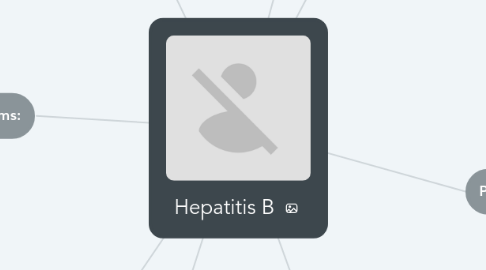Hepatitis B
by Jasmine Icaca

1. Host Response:
1.1. Definition: is the defence mechanism of the host against foreign organisms (6)
1.2. Soon after the hepatitis B virus (HBV) enters the body, it infects cells in the liver called hepatocytes. In response to this infection, the immune system tries to destroy the virus. The liver participates in this fight by increasing the amount of enzymes it manufactures, which causes inflammation of the liver (3).
1.3. The initial infection is known as acute hepatitis B, meaning short-term inflammation of the liver. Most people are able to clear hep B from the body within six months of becoming infected. If they clear it, they are no longer infected, nor can they infect others. Additionally, they now have hepatitis B antibodies, which will protect them from future reinfection (3).
2. Major Symptoms:
2.1. Definition: Evidence of disease (4)
2.2. Most infections occur during infancy or childhood. They are rarely diagnosed, as there may be few obvious symptoms.Symptoms of a new infection may not be apparent in children under 5 years of age and adults with a suppressed immune system. Among those aged 5 years and over, between 30 and 50 percent will show initial signs and symptoms.(1)
2.3. These include:(1) - fever - joint pain - fatigue - nausea - vomiting - loss of appetite - abdominal pain - dark urine - clay-colored stools - jaundice, or yellowing of the skin and whites of the eyes
3. Treatment:
3.1. Definition: the management and care of a patient to combat disease or disorder. (4)
3.2. Immune modulator Drugs – These are interferon-type drugs that boost the immune system to help get rid of the hepatitis B virus. They are given as a shot (similar to how insulin is given to people with diabetes) over 6 months to 1 year. (2)
3.3. Antiviral Drugs – These are drugs that stop or slow down the hepatitis B virus from reproducing, which reduces the inflammation and damage of your liver. These are taken as a pill once a day for at least 1 year and usually longer. (2)
4. Control:
4.1. Definition: Measures that prevent and contain the spread of infectious disease. (4)
4.2. Government Vaccine regulations. Will ensure that everyone is prevented against the disease. Not sharing needles. Seeking medical attention if similar symptoms occur.
4.3. If you have contracted the Virus you should avoid alcohol, high-salt processed foods such as meat, bacon and sausages and other fatty foods and saturated fats.
5. Cause:
5.1. Definition: a reason for an action or condition(4)
5.2. Hepatitis B is caused by infection of the body with the hepatitis B virus. The hepatitis B virus (HBV) is found in blood and bodily fluids. (1)
6. Transmission:
6.1. Definition: is the passing of a pathogen causing communicable disease from an infected host individual or group to a particular individual or group, regardless of whether the other individual was previously infected. (5)
6.2. Hepatitis B is transmitted when blood, semen, or another bodily fluid from a person infected with the virus enters the body of someone who is not infected. This may be through a puncture in the skin, a shared needle, or the exchange of body fluids.(1)
6.3. Infection can happen: - as an infected mother gives birth (1) - during sexual activity (1) - through sharing needles, syringes, or other drug-injection equipment (1) - through unsafe tattoo techniques (1) - by sharing personal hygiene items such as razors or toothbrushes (1)
7. Prevention:
7.1. Definition: the action of stopping something from happening or arising. (4)
7.2. A vaccine against HBV has been available since 1982. This is a series of three injections. The first injection is given soon after birth, the second at least 1 month later, and the third dose is given at least 8 weeks after the second dose.(1)
7.3. The CDC recommends that all children receive a birth dose of HBV vaccine and complete the series by 6 to 18 months of age.(1)
7.4. The complete vaccine series induces protective antibody levels in over 95 percent of people vaccinated. Protection lasts for at least 20 years and is usually lifelong.(1)
8. Footnoting:
8.1. (1) Davis, K 2018, Everything you need to know about hepatitis B, viewed 3 August 2019, <https://www.medicalnewstoday.com/articles/306288.php>.
8.2. (2) Treatment Options 2019, viewed 4 August 2019, <https://www.hepb.org/treatment-and-management/treatment/>.
8.3. (3) Hepatitis B Progression 2019, viewed 4 August 2019, <https://www.hepmag.com/basics/hepatitis-b-basics/hepatitis-b-progression>.
8.4. (4) Merriam-Webster n.d., Cause, viewed 4 August 2019, <https://www.merriam-webster.com/dictionary/cause>.
8.5. (5) Wikipedia n.d., Transmission (medicine), viewed 4 August 2019, <https://en.wikipedia.org/wiki/Transmission_(medicine)>.
8.6. (6) Your Dictionary n.d., Host Response, viewed 4 August 2019, <https://en.wikipedia.org/wiki/Transmission_(medicine)>.


